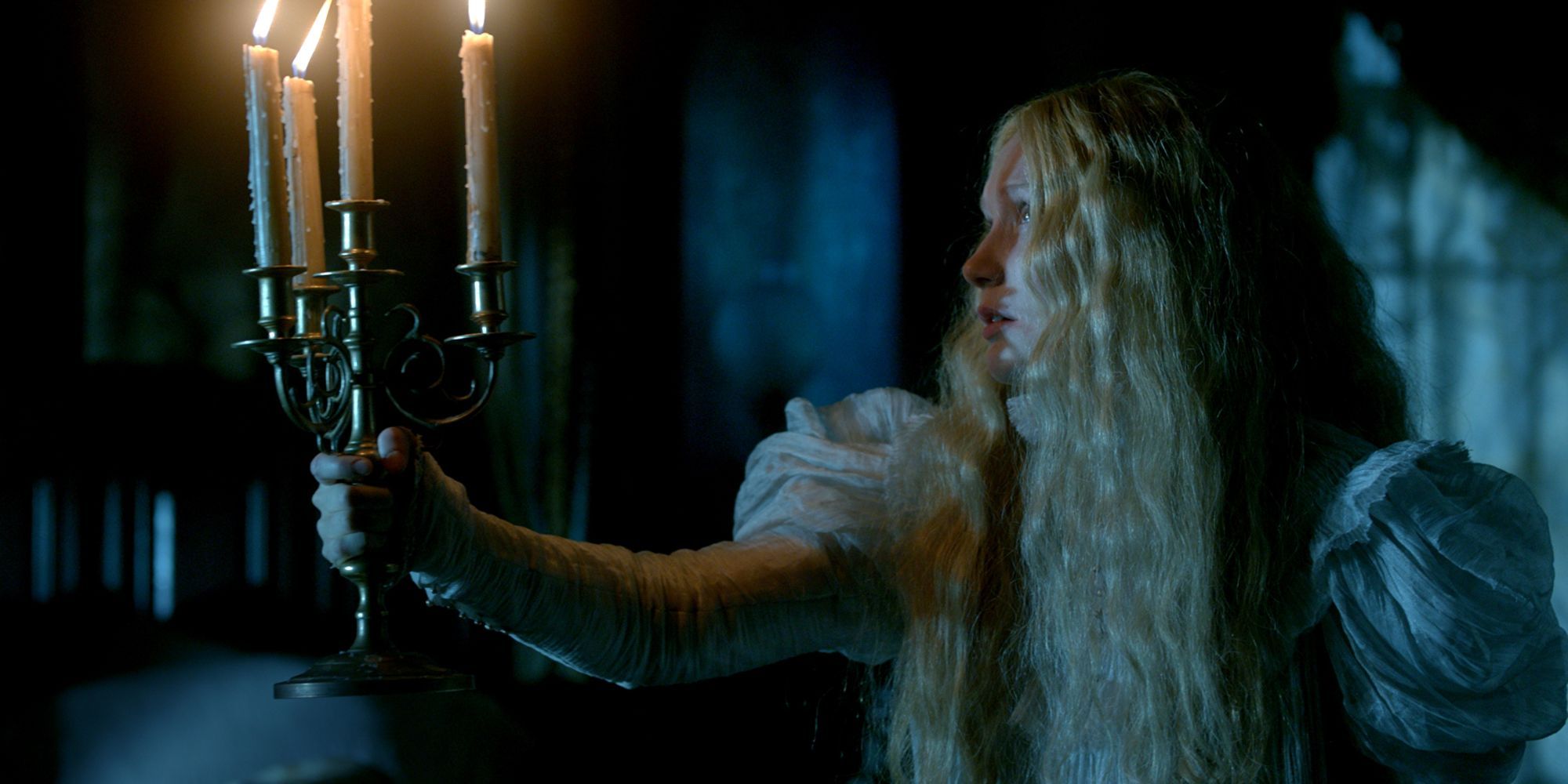Poor Crimson Peak. Although critics praised its art direction and moody atmosphere, Guillermo del Toro‘s lavish gothic romance earned only $75 million against its $55 million budget. It faced tough box office competition and in all likelihood suffered from poor marketing choices, which depicted it as an indie horror film rather than the love story with ghosts it truly was. Within del Toro’s oeuvre, the film also holds the tricky position of bridging his financially successful Pacific Rim and the Oscar-winning phenomenon The Shape of Water. As such, Crimson Peak seemed to come and go without nearly the splash it warranted both on its own merits and as a one-movie microcosm of one of modern cinema’s most lauded visionaries; a director’s origins and passions, distilled.
Set primarily in early 1900s England, Crimson Peak follows Edith Cushing (Mia Wasikowska), a recently orphaned writer of horror stories who finds herself wooed by and wedded to the enigmatic Thomas Sharpe (Tom Hiddleston‘s second-best career performance) in record time. All appearances indicate Edith is living out a romance sweeping enough to put the likes of Jane Eyre and Rebecca to shame, but she carries a burdensome secret. The most unique trait setting her apart from Edwardian society is her ability to see ghosts. And the desperate spirits haunting her husband’s crumbling family home of Allerdale Hall, nicknamed Crimson Peak, won’t leave her alone.
Del Toro Had Many Inspirations for ‘Crimson Peak’
In an interview promoting the film, del Toro cited 1963’s The Haunting, Stanley Kubrick’s The Shining, and The Innocents, an adaptation of Henry James’s The Turn of the Screw, as masterclass examples of the haunted house film. “I wanted this to feel like a throwback,” he said. “It will allow me to play with the conventions of the genre I know and love, and at the same time subvert the old rules.” And play del Toro did. Much like Pan’s Labyrinth and The Shape of Water, a fairy tale grandeur runs through Crimson Peak like an exposed vein. Every frame bursts with an unabashed love for the genre’s essence: the flicker of a tall candle in the dark, the trailing hem of a billowy nightgown, blood dashed upon the snow while the cruel winter winds roar; the house itself bleeds as a metaphor. Also present are Del Toro trademarks like production design so painstakingly detailed it could carry the narrative, a breathtaking wardrobe symbolic of the characters’ arcs, and color palettes conveying tone. Edith’s last name is an homage to Hammer Horror veteran Peter Cushing, while the effortlessly sensual Hiddleston embodies every morally gray but delicately tortured heartthrob of the time, whether it be Mr. Rochester or Vincent Price circa The Tomb of Ligeia. Thomas’s sister Lucille (Jessica Chastain) completes the precariously balanced trio by fulfilling the Mrs. Danvers archetype alongside some Flowers in the Attic affectations.
But Crimson Peak isn’t just reveling in the glory of esoteric husbands and creaking staircases. When considering the film’s whole, del Toro consciously incorporated elements from almost every formative influence responsible for his career. The list is abundant and sumptuous: he credits literary pioneers Ann Radcliffe (The Mysteries of Udolpho), Daphne du Maurier (Rebecca), and Charlotte Brontë (Jane Eyre), directors Mario Bava (Black Sunday) and Terence Fisher (The Curse of Frankenstein), Victorian painters and architecture, and his own family’s experiences with the supernatural. Every Del Toro venture is a passion project in some capacity, but Peak’s intent rings especially distinct: it’s a love letter to the art of storytelling itself. Edith’s role as an author can’t be a coincidence, especially one whose passion is writing horror instead of what mainstream interests dictate. Nor is her arc of realizing her work does, in fact, need a love story to give it true life. All stories must mean something, so why not celebrate love?
“The Horror Was For Love” — But Shouldn’t It Be For Good?
Because despite some tense sequences where Edith communicates with the phantasms roaming Allerdale Hall, del Toro’s far more preoccupied with the ways love can empower, heal, and redeem. Edith is already an assured young woman at the film’s start, but after her father’s death, she draws renewed strength from her genuine and unexpected connection to Thomas. She feels accepted, and, what’s more, wanted, for the very quirks that always drew scorn in the past. Thomas, meanwhile, experiences a healthy relationship for the first time. Unlike Elisa (Sally Hawkins) in Shape of Water or even Hellboy‘s Liz (Selma Blair), Edith doesn’t realize until too late that she loves a monstrous figure, but Thomas unconsciously longs for redemption. He’s an anti-hero at the least and as trapped within his ancestral legacy as any ghost. And unlike Cronos‘ harrowed protagonist, Gris (Federico Luppi), he’s unable to escape his toxic bindings. If love can redeem, then the reverse holds true and acts committed in the name of the “monstrous love” that “makes monsters of us all” rot humans away long before they become corpses — a prominent motif in the director’s work.
In true del Toro fashion, the grotesque ghosts are innocent victims and the attractive humans are killers. Lucille and Thomas’s incestuous relationship and string of murdered wives are crimes suited to the genre but no less thematically relevant than Pan’s Labyrinth, The Devil’s Backbone, and Shape of Water. The first two take place against the backdrop of the Spanish Civil War, while Shape of Water centers its action during the Cold War when American xenophobia, homophobia, racism, and misogyny ran rampant. As such, all three double as fairy tale parables and Crimson Peak is no different in this regard. The Bluebeard folk story is an obvious parallel to Thomas and Lucille’s misdeeds, but textually, Edith bears some similarity to Carlos (Fernado Tielve) from Devil’s Backbone. Carlos is an orphan boy who, like Edith, receives warnings from a murdered ghost seeking justice. Likewise, Ofelia (Ivana Baquero) of Pan’s Labyrinth is a reincarnated mythical princess able to see both the hidden majesty and the perverted horror inherent to the world. True fairy tales didn’t sanitize their moral warnings, a fact del Toro has favored and elevated over the years.
Closing the circle of his works is the recently released Pinocchio, which Del Toro reinterprets through the lens of 1930s Fascist Italy. Pinocchio was created to love and spread unconditional love. Lucille tells Edith that “the horror was for love,” but Lucille’s love isn’t worth the cost. True love uplifts and frees, and is often found in unexpected places and with the benevolent creatures disdained by the worst of humanity. Even Pacific Rim’s founding principle is one of empathetic connection and peaceful collaboration.
‘Crimson Peak’ Is a Director in His Prime
As the misunderstood masterpiece of Del Toro’s pantheon, Crimson Peak blends the confident regality of Pan’s Labyrinth, the heart of Pacific Rim, and the feminine strength of Shape of Water, among others. It champions finding beauty in the grotesque and embraces the oddballs. In a way, Peak feels like a film made solely for del Toro, an amalgamation tribute to his creative touchstones that walks hand-in-hand with his singular imagination. Even more so than Shape of Water, which won him the Oscars for Best Director and Best Picture, Crimson Peak is the perfect example of a director in his prime.










































































